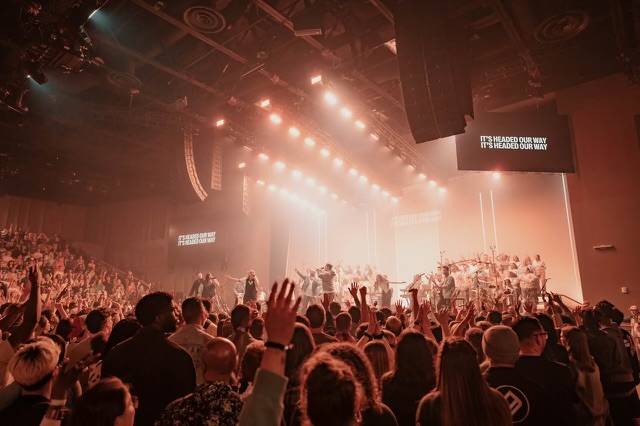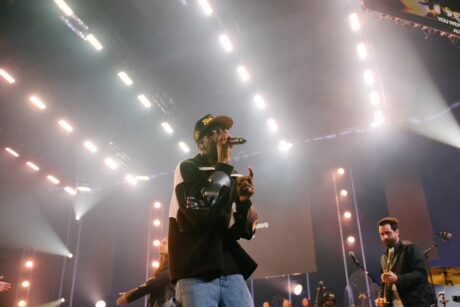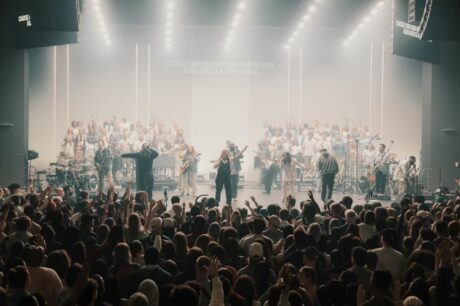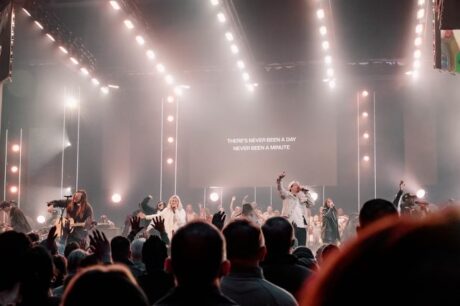
Video walls and lights work hand-in-hand in production design, but sometimes, like when your goal is to create a seamless look for a broadcast recording, you might want to lose the LED panels and rely solely on lighting fixtures to generate visual energy. This was the strategy that Matt Hemmele followed recently when lighting the widely acclaimed Elevation Church Night of Worship.

Elevation Church’s Broadcast Designer, Hemmele employed a bold, innovative solution for creating dynamic looks in his “no video wall” production. Rather than including a variety of different fixture types in his rig, he relied almost exclusively on a single product, albeit an incredibly versatile one, to create a stunning production that not only came off beautifully on video, but also engaged the crowd of 2,000 at the church’s Ballantyne, NC campus.
Aside from a small number of linear LED units behind the scrim, Hemmele lit the entire two-hour recording exclusively with the CHAUVET Professional Color STRIKE M, which, like the rest his rig was supplied by Main Light. “We wanted clean upstage look, which to us meant no video wall,” said Hemmele. “But we still need to display song lyrics, so we rented a 35k projector for that purpose. This preserved our clean looks.”
Generating the visuals without the video wall were 83 Color STRIKE M units, 56 of which were in the overhead rig, while nine were positioned down-stage for crowd lighting, six on mid-house truss to provide fill light for the stage and crowd, as well as 12 on the deck to light the scrim. Speaking of the 56 overhead units, Hemmele noted: “We used 46 of them as the main top key and relied on them to provide dynamics while on the front and back tips of each truss. We also had them work as a crowd blinder and upstage fill for the white scrim.”
 All the Color STRIKE Ms were run at 208V. “This allowed Hemmele to run more fixtures per circuit. The sheer number fixtures powered up a level of intensity that made it easy to bring the room to life. However, Hemmele was careful not to overpower the choir and band on stage, so the energy they generated could shine through. “These fixtures have so many attributes, they allowed me to create a variety of interesting looks and movements, so we didn’t worry about repeating things,” said Hemmele. “Whenever I use the Strikes, I break them down into three groups: Strobe, Color, and Main.
All the Color STRIKE Ms were run at 208V. “This allowed Hemmele to run more fixtures per circuit. The sheer number fixtures powered up a level of intensity that made it easy to bring the room to life. However, Hemmele was careful not to overpower the choir and band on stage, so the energy they generated could shine through. “These fixtures have so many attributes, they allowed me to create a variety of interesting looks and movements, so we didn’t worry about repeating things,” said Hemmele. “Whenever I use the Strikes, I break them down into three groups: Strobe, Color, and Main.
“In this case I used the strobe as our home base for brightness and color, then used the color attribute to add both warm and cool tints as well as more granular dimmer effects as I ran the main grid in 74 channel mode,” continued Hemmele. “I then used the Main as overall brightness, accent hits, and larger scale dimmer effects. With each truss having between 8-10 strikes on them, I essentially had a large scale PXL curve that built some “curve” position presets to create some interesting texture to the grid. Leveraging all of these attributes not only allowed me to keep track of what I was using so looks didn’t get overused, but also kept a consistent base look throughout the night.”

Brightness was essential to Hemmele’s vision for this production. He valued the Color STRIKE M fixtures, because they gave him the flexibility to create nuanced looks even in the brightest moments. “I don’t always need to turn on the sun, but it is helpful knowing that I could,” he said. “Sometimes getting the brightness needed for the cameras doesn’t leave a lot of room for added dynamics, but with the Strikes, we had plenty of headroom to play with. Having the strobe and color plate in one fixture is an incredible asset,” continued Hemmele. “The insane brightness that they both have creates really high dynamics, and it allows me to layer on accent hits and sweeps that really punch through. The tilt is an added dynamic that really put these over the edge in helping create interesting looks that didn’t grow stale throughout the night.”
Crowd lighting was also high on Hemmele’s priority list. Given that the recording is for an album, he wanted to ensure that the audience really popped for the camera. Throughout most of the production, white was most prominent in the lighting palette, whether for the audience or stage. “Regarding color, we generally stay with white,” he said. “However, for this one we tinted either warm or cool depending on what was going on in the moment. We set a home base for brightness and color and then add dynamics on top of that.” Hemmele’s artful balance of colors, movements, and brightness levels were done to achieve what he calls “a great capture” for a live broadcast recording. It’s a goal he achieved in stunning fashion with help from one very versatile fixture.

Further information from CHAUVET Professional: www.chauvetprofessional.com


